By Hayley Babbitt
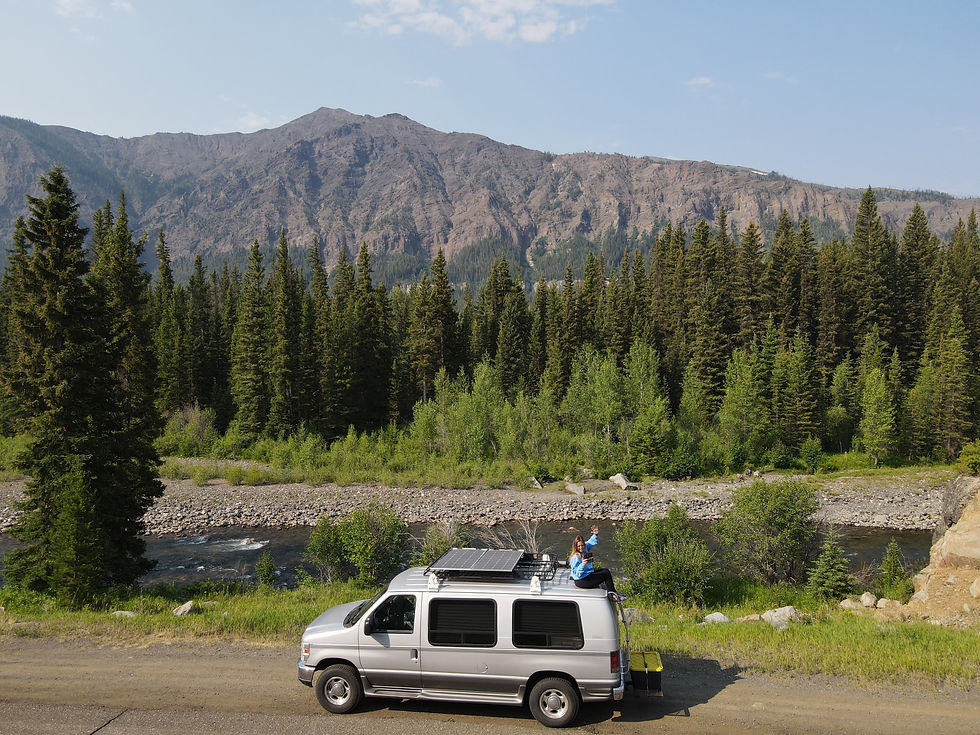
Above: Me, flying my drone from to the top of my van (Vinny) on the Beartooth Highway in Wyoming, USA. 2021 by Hayley Babbitt.
People who lead a nomadic lifestyle all have different reasons for doing so. Some of us want to set out for the adventure of the open road, others to get away from society - and sometimes, both (like myself). Whatever your reason is for wanting to live life on the road, I have found that we all have one thing in common: living out of a vehicle. Depending on what vehicle you call "home", there will be varying trials and tribulations you will experience.
In this guide, I will be outlining how I personally started what is now being called the "van life", as well as providing tips and insight on what living on the road is like for a young woman traveling alone. Keep reading to find out what you need to get started, how to convert a van, and the ins-and-outs of living in a van.
Disclaimer: This guide is written with no intention of promoting the "van life" you may see on social media. Social media has glorified living on the road by social media influencers that do not correctly portray the average person's life living out of a vehicle. This, in other words, is a no-bullshit guide on what the "van life" really is, and how to get started living this lifestyle.
Table of Contents:
Is the van life for me?
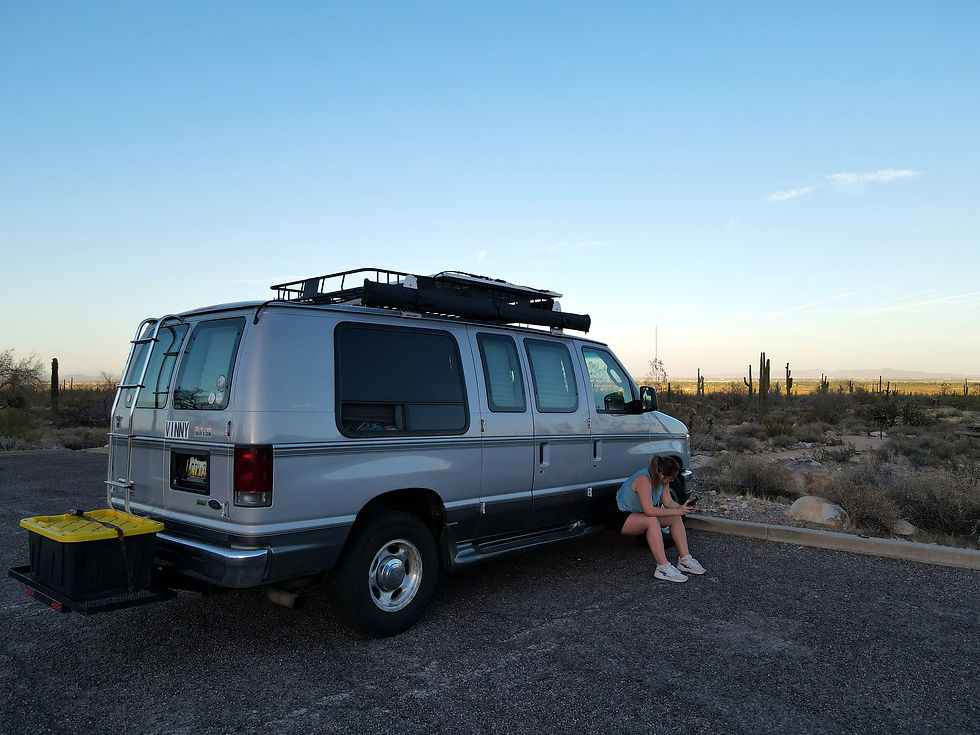
Above: Me, playing with my drone near the White Tank Mountains, Arizona. 2021 by Hayley Babbitt.
Don't be fooled by what you see online.
Surprise, "living in a van down by the river" isn't for everyone. Although I don't want to start off on a negative, I want to be 100% transparent in this guide, which includes proposing this key question right off-the-bat: "Is the van life for me?"
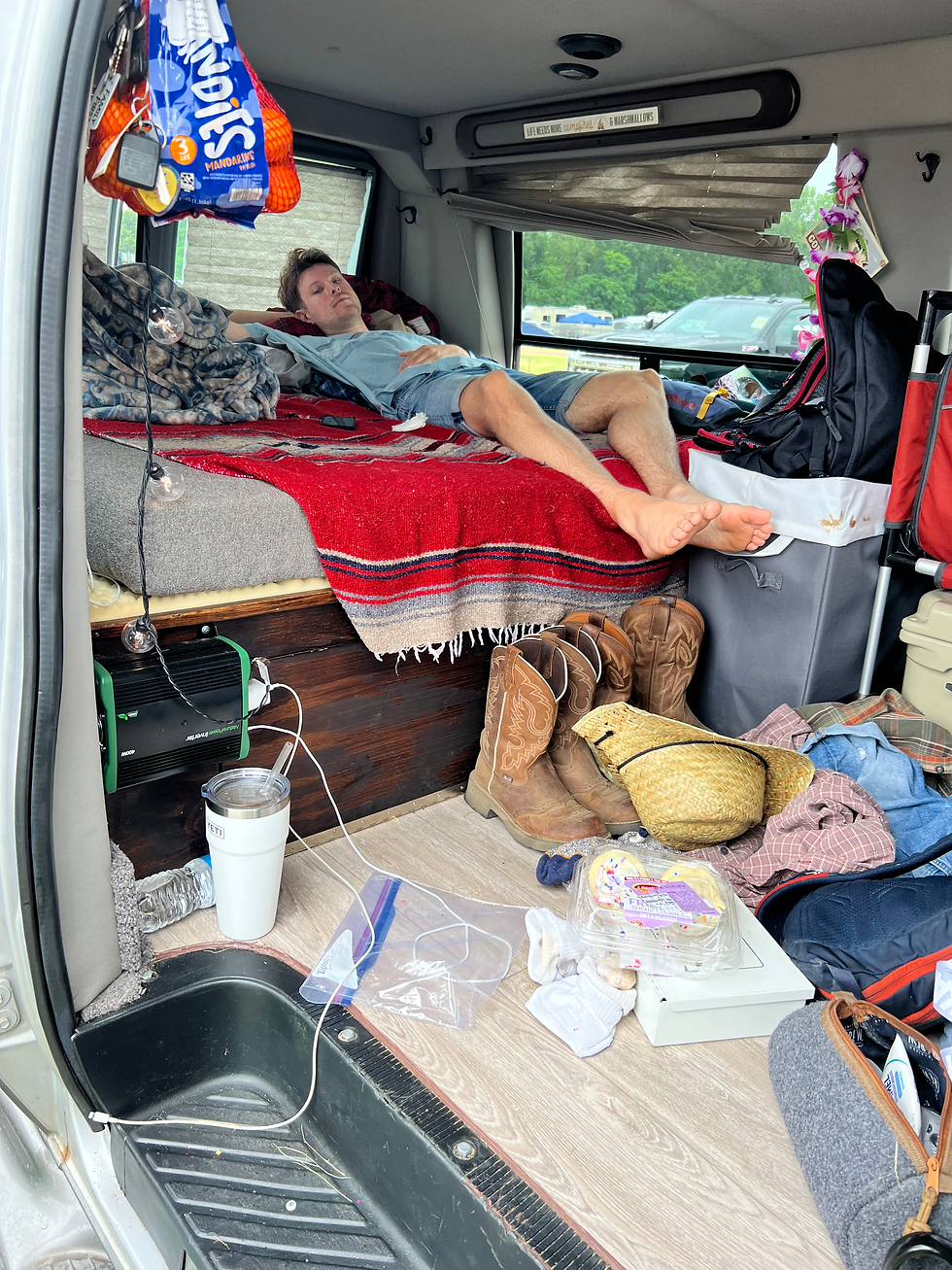
Above: Yeah... sometime's van life can look like this. Luke chilling in my van, Vinny, at the Faster Horses music festival in Brooklyn, Michigan. 2022 by Hayley Babbitt.
Despite what you might have seen on social media, living the van life isn't going to be sunshine and rainbows 100% of the time - just like anything in life. If anything, you will probably find the van life to be quite the opposite of sunshine and rainbows at times, considering your previous apartment or house probably wasn't in need of constant maintenance and on four wheels. It takes a special person to want to downsize to less than 100 square ft., and it comes with a few of its own challenges.
The biggest hurdle to overcome when transitioning to van living is giving up the "luxuries" of your previous lifestyle. Whatever comes to mind when you think of "luxury" now will most likely soon change when you find yourself thanking God for plumbing and running water someday on the road. It depends on how far you go with your vehicle conversion, but I personally don't have a toilet, shower, running water, or refrigeration system in my van. Now that I'm a few years into the van life these things don't matter to me so much, but I still remember how uncomfortable not having those luxuries were during my adjustment period on the road.
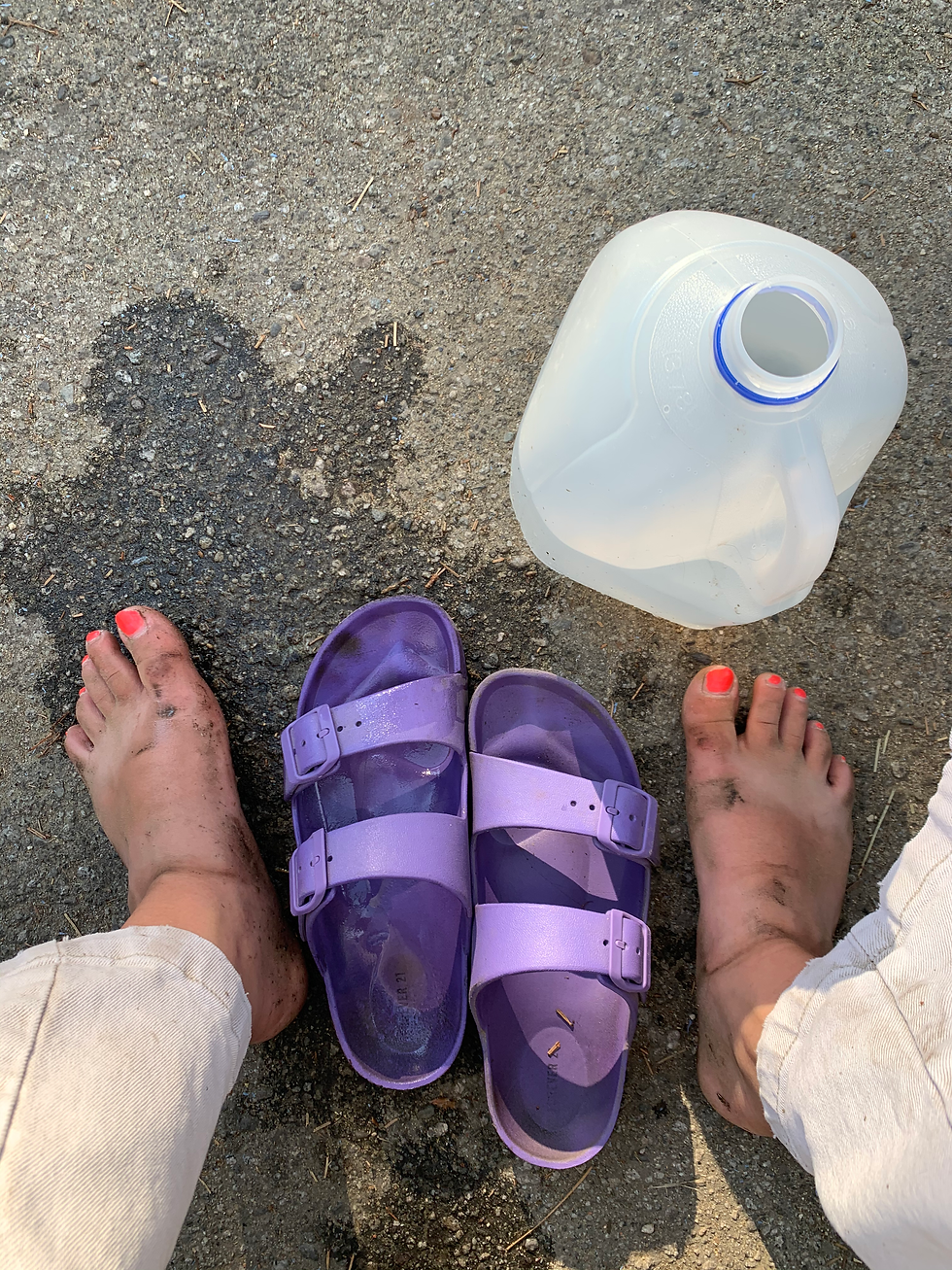
Above: Giving my dirty feet a bath via my gallon water jug, somewhere in the Tahoe National Forest, California. 2021 by Hayley Babbitt.
Trading your shower for truck stop showers and gallon water jugs, your refrigerator for a cooler, bedroom for a vehicle, and home for anywhere you can find that night, you will now be finding comfort in the uncomfortable. For those who can adapt to this lifestyle, you will find yourself more content with the less trivial problems of life and having less. However, for the van-lifers that do have all of the amenities imaginable converted into their vehicle, all I have to say is: it must be nice. I really do believe that the amenities in your conversion vehicle will highly dictate your comfort in the beginning of your experience; but this is not to say that it determines the overall quality of life. A lot of what you experience on the road is up to what you make it.
The Cost of Living the "Van Life"

Above: My work van, parked on the shoulder of the road somewhere in North Dakota, USA. 2022 by Hayley Babbitt.
Why it is common for van life to be misperceived as such an expensive way of life is beyond me. What used to be known as a poor man's way of life is now suddenly seen as a lifestyle exclusive to trust fund babies, thanks to the rise of the glorification of van life we see on social media. To be up front, you can make van life just about as expensive or inexpensive as you want. One of the many freedoms you get living on the road is getting to choose which way you want to do it.
Aside from the conversion cost or overall vehicle cost at the start, the lifestyle itself can be enjoyed with very little money for those who are comfortable with giving up some luxuries. But, for your average person doing van life in the United States, you're probably going to end up spending around $1,000-$1,500/month if you are traveling. For those who stay in place for a while and work on-site, this will be less as you are spending less on gas. Obviously how much you spend per month depends on the individual, but that is around how much I spend when traveling through several states each month and enjoying myself.
Now, let's put this cost into perspective. When I'm being asked the typical question, "how can you afford van life?", It's usually being asked by a young college student (from my experience). Realistically, at the end of the month your average American college student is probably spending around the same amount of money as I am traveling the country in my van. Including the college tuition, they spend a lot more than I do.
Anyone paying rent in 2023 in the United States is typically spending at least $800 per month (on the low end), and then there's utilities to pay, a water bill, heat bill etc. Of course there's some money you will have to invest in your vehicle just as you would your home or apartment, but these bills are far less consistent and generally don't cost as much. When you put two and two together, it makes sense that you would be saving money living in a vehicle rather than paying rent or having a mortgage.
Bottom line: we're not so different you and I. Everyone has to put their money somewhere, we just choose where we are putting it.
Van Life Challenges
Challenge #1: Where do I sleep tonight?
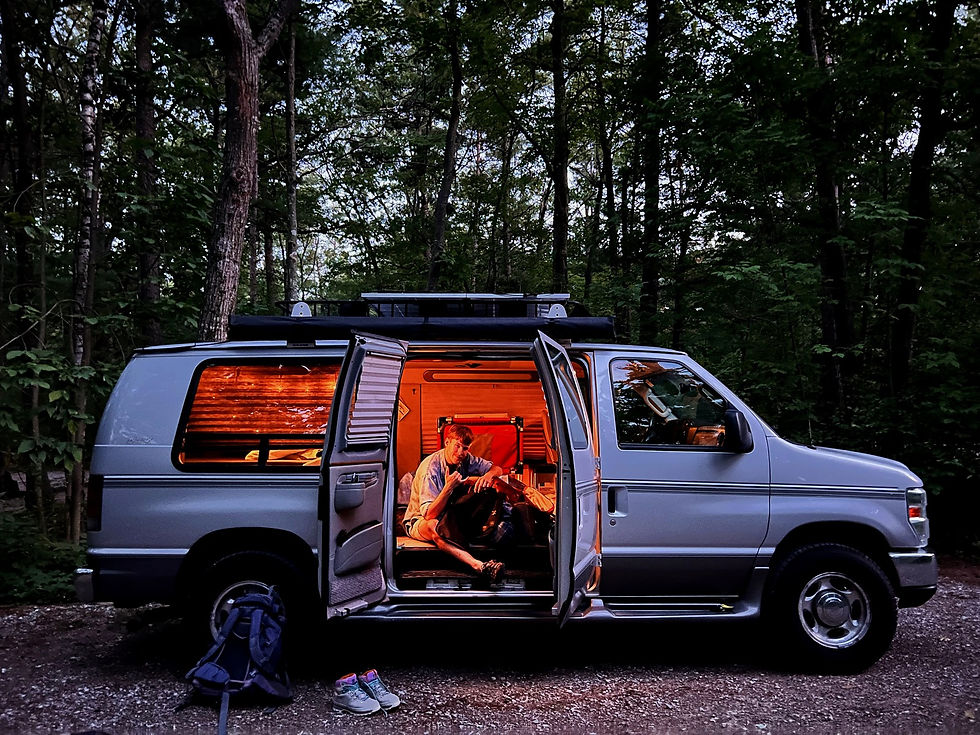
Above: Luke, going through his pack inside of Vinny. 2022 by Hayley Babbitt.
When you make the transition to van living, what may surprise you the most are the questions you find yourself asking that you simply have never had to mind before. Before living on the road, I had the privilege of never having to guess where to sleep at night. On the contrary, finding a place to sleep on the road will be one of your most frequent issues on the road - especially for the urban/suburban van-dwellers. Major cities are very limited on overnight parking options, let alone without cost. This issue can force you into sleeping in rough areas, upping your safety risk for that night(s).
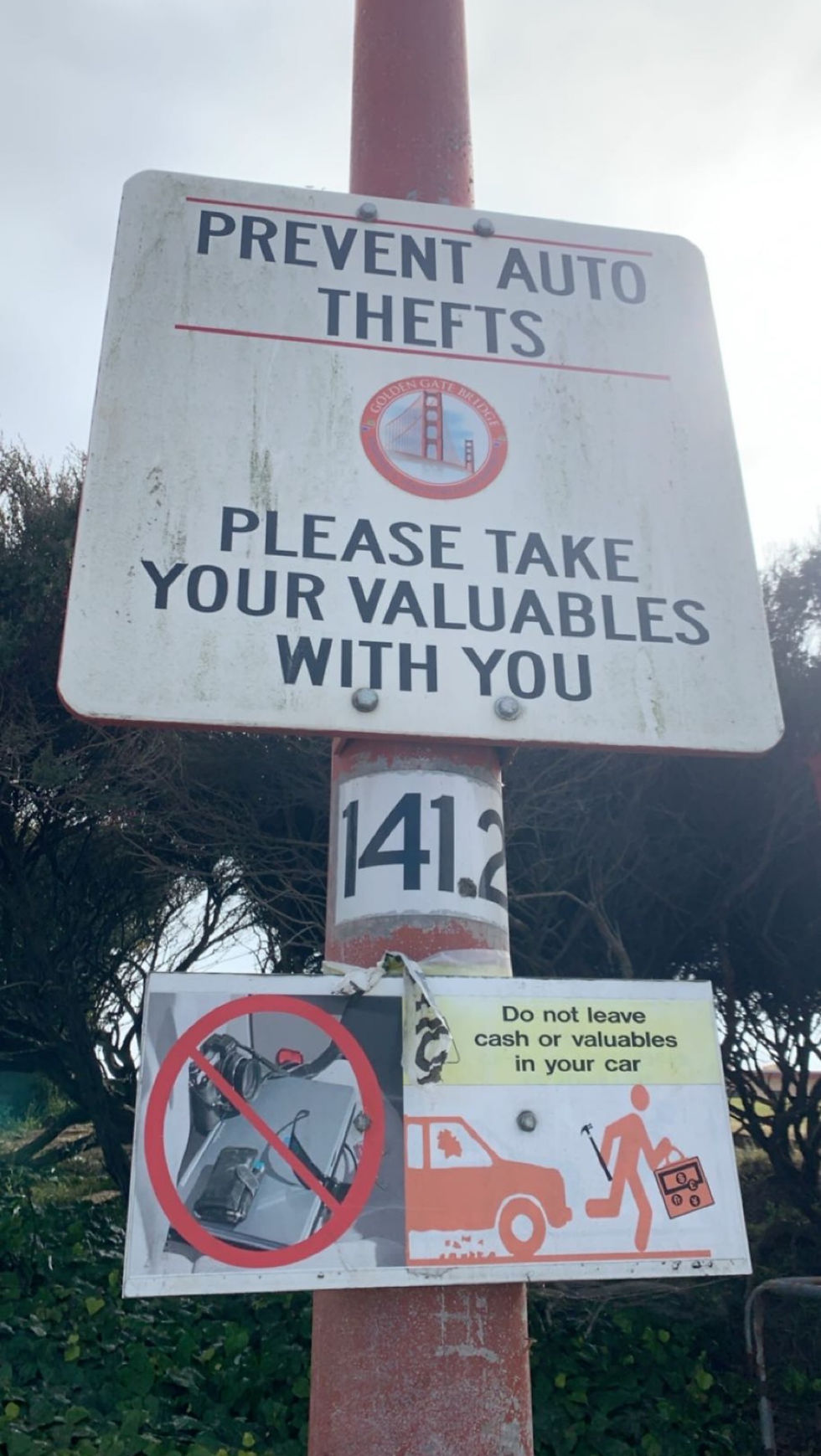
Above: Auto theft warning sign in the Golden Gate Bridge visitors parking lot. 2021 by Hayley Babbitt.
I have definitely risked it when camping out in some major cities, one of the biggest being San Francisco, California. In the congested Bay Area of California, not to mention rampant with grand theft auto, van camping can seem almost impossible (not to mention dangerous). In most parking lots in San Francisco, there are signs posted warning to take all of your important belongings with you when leaving your parked vehicle due to the big GTA problem. I definitely did not get the best sleep when camping in bay area parking lots with the thought of someone stealing the solar panels off of the roof of my van in the back of my mind.
In suburban areas, my preferred camp spot is in Walmart parking lots or hotel parkings lots, where it's well lit at night and easy to blend in. Truck stops and rest areas are two excellent places that are often misconceived to be sketchy, considering there are usually other people around and/or cameras on the premises. Avoid parking overnight in neighborhoods unless you really have to, as the neighborhood residents might not feel comfortable with a big, anonymous conversion van camping out in front of their yard (I know, it seemed like a good idea at first).
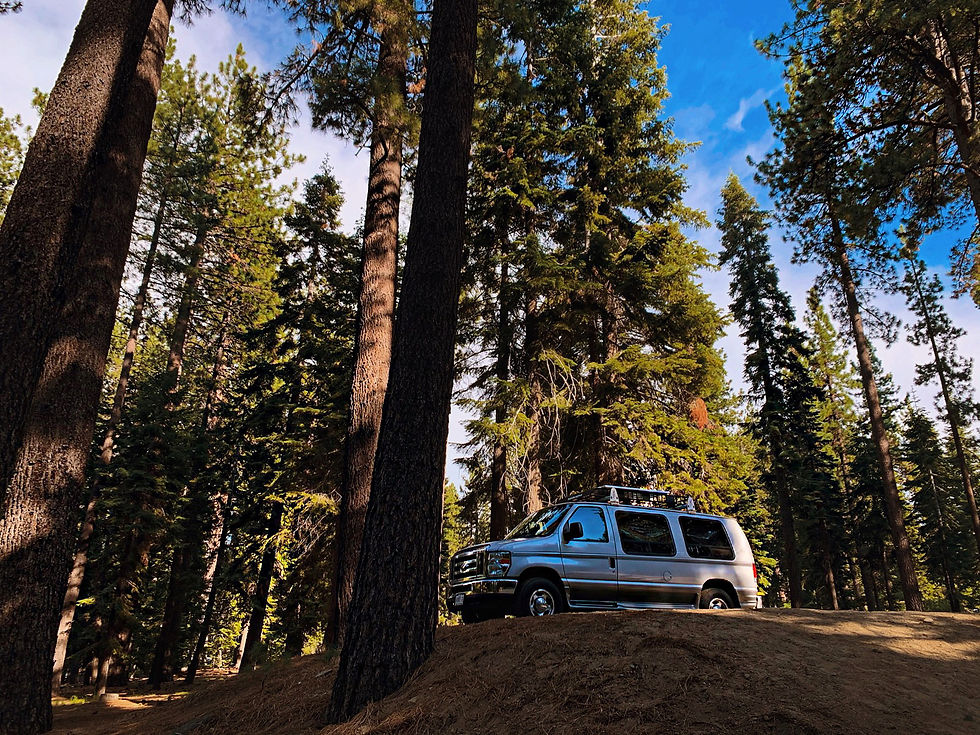
Above: Vinny the van parked at our campsite at the Fallen Leaf Campground near Lake Tahoe, California. 2021 by Hayley Babbitt.
When in more remote areas, the pressure for finding camp is not as big of an issue (typically). If you are planning on making camp in more popular wilderness areas, such as the surrounding towns of high-traffic National Parks (ex: Yellowstone National Park), it may be a little bit harder to find a spot, but not anything like it is in an urban area. Using your navigation skills, you can download maps from BLM (Bureau of Land Management) online to find public land to camp on when in secluded areas. Other free overnight camping options in remote areas include trailheads (that allow it), campgrounds, and (rarely, but sometimes) shoulders on slow-speed mountain passes.
Challenge #2: How do I shower?
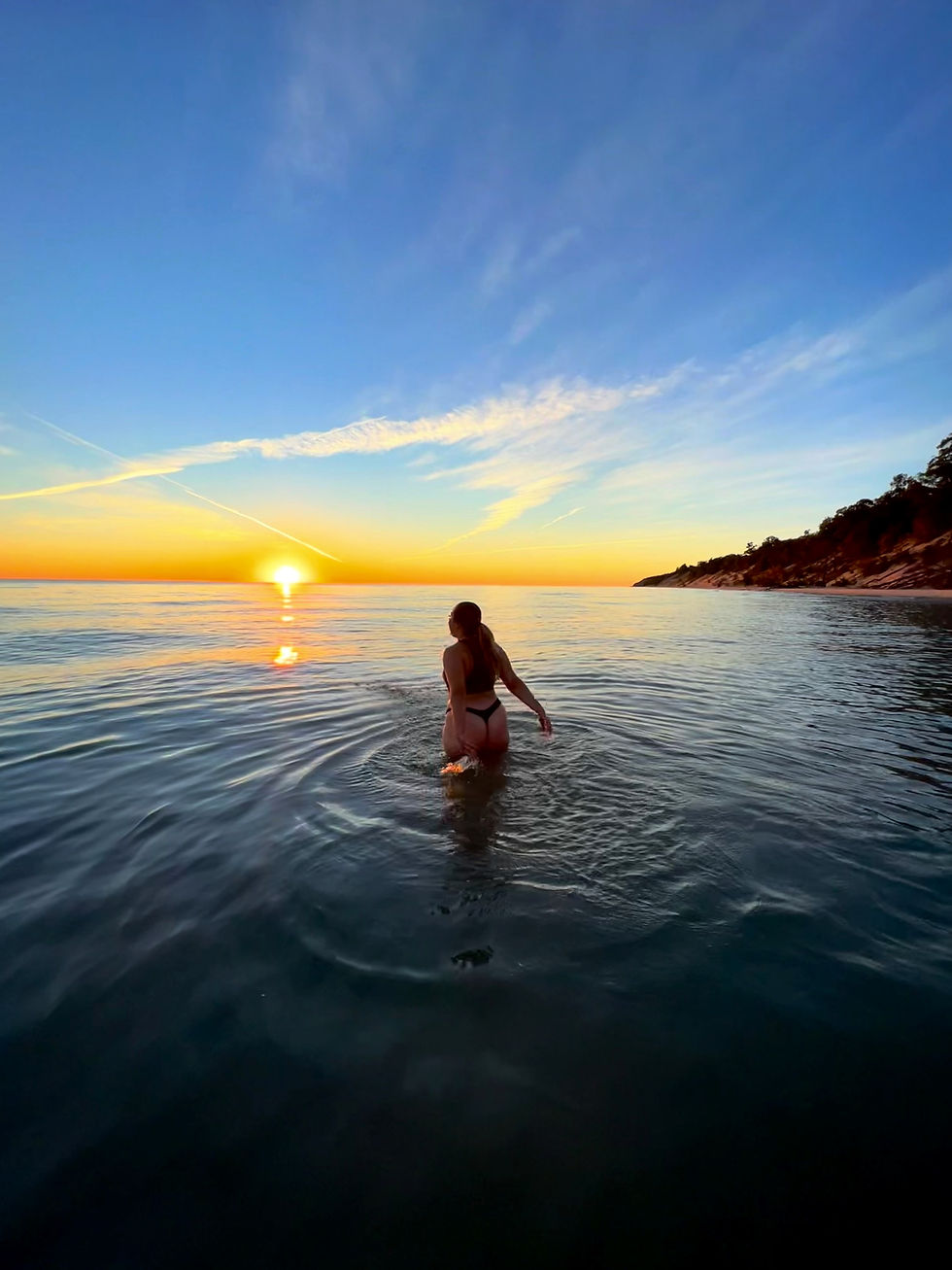
Above: Me, taking an evening bath in Lake Michigan. 2022 by Hayley Babbitt.
Many van dwellers today have some sort of shower system in their conversion, however, some of us rely fully on natural water sources and/or public showers to do our washing. Due to sometimes settling in urban areas for a period of time, I don't find the popular solar-heated shower bag private enough, and my van isn't big enough to hold an indoor shower. Because of this, I usually shower at truck stop showers (mostly Love's); and they are perhaps some of the best, most underrated showers in America. With a giant, private shower room, provided with clean towels, shower accessories, and a personal toilet, truck stop showers are nothing short of a luxury on the road. However, the price of these showers can add up rather quickly. With truck stop showers ranging anywhere between $7 and $17, staying clean can come at a cost.
Aside from having your own personal on-the-road shower set up or frequenting the truck stop showers, one of the most popular showering options is to utilize public gyms. Gyms like Planet Fitness have public showers for all members, and can be a more cost-effective way to pay for a shower. Not to mention, this is a nation-wide chain so it's convenient for people who travel a lot.
As for your free option, the only way to truly shower for free is in lakes, streams, and other sources of relatively clean water. Just make sure you are using eco-friendly shower gels and hair products when bathing in natural water sources.
Challenge #3: Mother Nature is Your Thermostat...
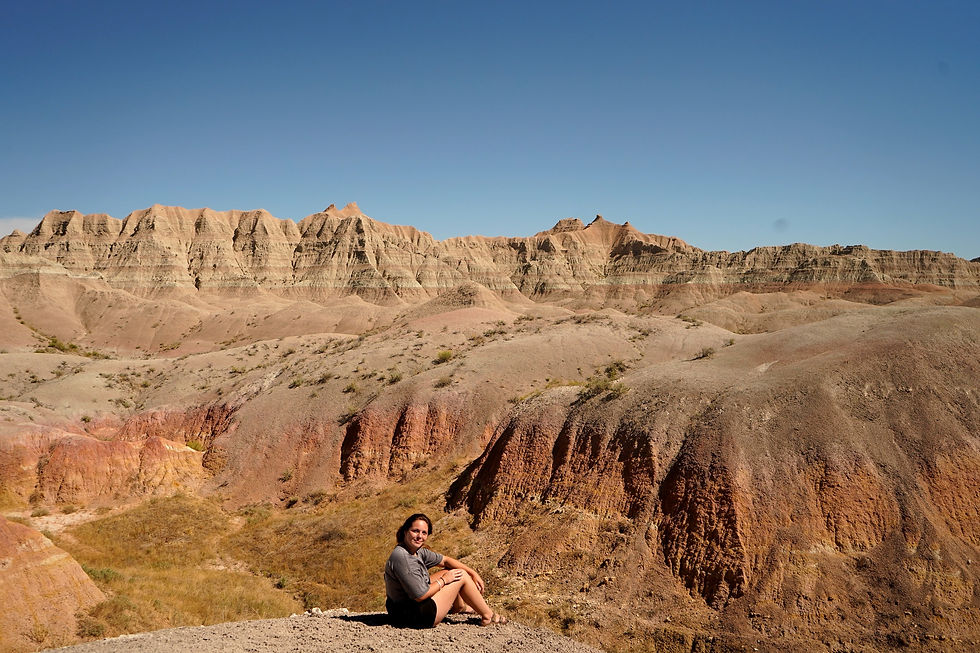
Above: Me, sitting in the Badlands National Park, South Dakota. 2020 by Hayley Babbitt.
Perhaps one of the most physically uncomfortable adjustments to make in your van life transition is getting used to the weather. If you do not have a means to control your inside vehicle temperature (when the vehicle is off of course), which most of you will not, you best prepare for your sleeping setup everyday. Weather can be rather unpredictable just about anywhere, and while living out of a vehicle will be much more significant to your daily live than ever before.
When I was camping in Arizona during July of 2021, the heat made my mornings miserable. No later than 5am was I able to sleep in, as the heat from the hot Arizona sun surely got my ass up and out of my van. Some nights in the summertime out west I had to sleep with all of my vehicle doors fully open, and I would still be sweating my way to sleep. On the flip side, I can recall having to stuff my sleeping bag with my wadded up, dirty clothes to keep me warm while sleeping in a good ol' Wyoming blizzard. Thanks to the foot of snow atop my solar panels on my van, I also didn't have any power for a couple of days, which made for not only freezing nights of sleep, but dark, too.
At the end of the day, just don't be surprised if your "bedroom" isn't the perfect temperature to sleep in. Just be calm, evaluate the temperature, and use critical thinking to adjust your sleeping setup before throwing in a couple of hundred dollars toward a hotel room.

Above: A view from outside of the windshield of my van in the Truckee, California area. December 2022, by Hayley Babbitt.
Challenge #4: Expect the Unexpected
Overall, most of the van life challenges come at a moment's notice. You do live out of a vehicle, afterall. Every day on the road will truly feel like a brand new day, with new challenges and experiences presenting themselves constantly. Because of this, the main trait to have going into van life is being adaptable. When your home can break down on you at any moment, and your power is reliant on how sunny it is that day, there's a lot of small things you will probably need to adjust on a daily basis.
As long as you face your problems head on and get what needs to be done in a timely manner, you will quickly adjust to the everyday happenings of a van-dweller. Just make sure to be prepared for randomness happening on the daily, and keep in mind that most of the chaos is good - enjoy it!
Making Money

Above: Logo for my drone company Mach 5 UAV. Logo: 2020 by Arika Hoffman.
My personal favorite way I made money while traveling was my startup drone company, Mach Five UAV, in which I traveled around the country in my van doing various drone jobs for people. I would advertise online in whatever area (typically a state or city) I wanted to travel to next, and then would have drone jobs waiting for me when I got there. Once on location, I would fly my drone to take aerial photos and videos (and sometimes create edited video advertisements) for businesses and independents (mostly real estate). Bottom line, if you are creative enough to want to live on the road, you can get just as creative when it comes to making money.
Above: An example of my drone work for a vineyard in Temecula, California. 2021 by Hayley Babbitt.
In 2023, one of the most popular jobs for van-lifers is social media content creation/influencing. Now, there are big upsides as well as big downsides (like with every job) to doing content creation. Consider how if you are content creating, most of what you will end up doing in your lifestyle will be for the sake of filming or photographing it. But also consider the opportunities (free ones, too) that could come out of successful content creation.
Know that content creating, especially when it comes to nomadic lifestyles, is highly saturated with thousands of influencers; so you should have some strong photography/videography skills to make your content stand out. If you don't quite have the experience to start content creating, start anyways! The more you start creating content, the better you will be - just don't expect to be making any money until you become one of the best at doing it.
Other popular jobs amongst nomads tend to also be online/"laptop jobs", or what we now call remote work. Teaching English online via Skype is one of the biggest jobs on the rise for van-lifers, as well as blogging (as I'm doing now). When I first started van life, my job I left home with was a remote coding job on my laptop for grocery store chains around the United States. It was a pretty random job, just like a lot of online jobs these days, but it allowed me to work 20-40 hours/week whenever I felt like working. It was great to have the choice of when I worked due to not always having reliable internet on the road.
Van Life Safety
Unfortunately, van life can be dangerous. With this being said, safety concerns vary on the individual when it comes to life on the road. For example, a young girl traveling solo will have a little bit more risk in safety than two men traveling on a work trip. However, this is not to say that there are not safety risks for everyone living on the road, whether or not you are alone or with company. Your level of common sense, critical thinking skills (problem-solving), navigation, and being able to defend yourself all play into making sure you are safe on the road.
Knowing Your Vehicle
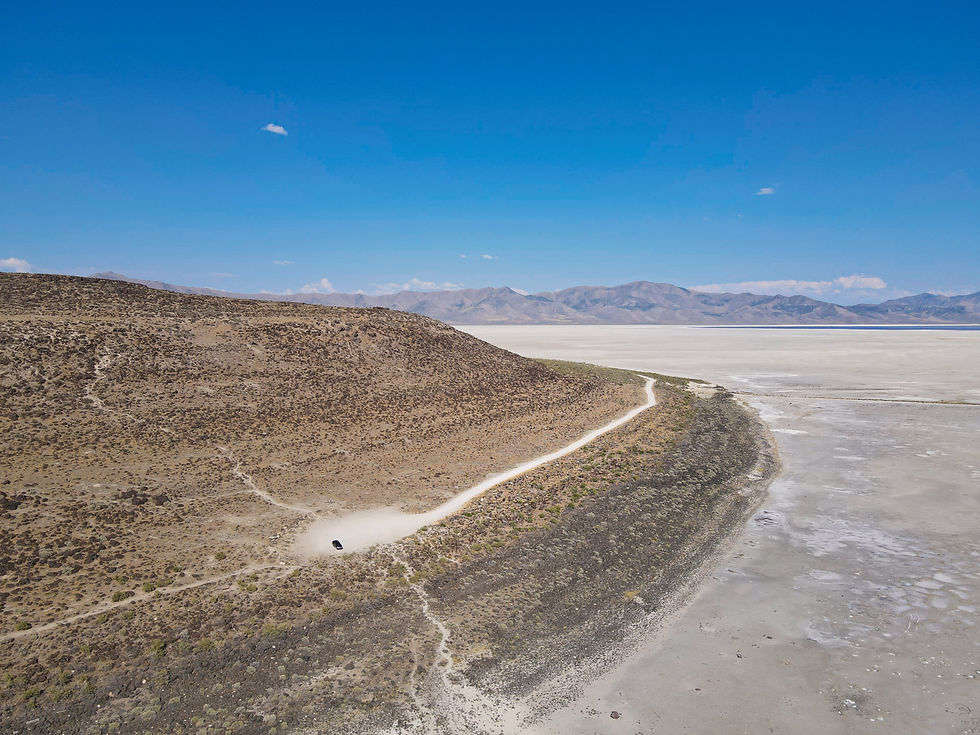
Above: Aerial view of the Spiral Jetty in Utah, United States. 2021 by Hayley Babbitt.
The most commonly overlooked skill when it comes to this lifestyle is automotive knowledge. Knowing your vehicle and how it operates is key, just like having an apartment or home and knowing how to keep it up. For the suburban/urban van dwellers, this won't be as big of an issue as there are likely plenty of mechanics around. But, for the "out there" van dwellers that like to camp a bit further from society, having an automotive background (at least when it comes to your van/conversion vehicle) is crucial. Triple A doesn't do much help when you are broke down 30 miles from cell phone service.
Navigation Skills
Navigation is, at this point, almost a lost skill. With Google Maps, Apple Maps, etc., it's just about unheard of for people to use physical maps (let alone understand how to truly read one). Call me old-fashioned, but I'm here to tell you why having these strong navigation skills are essential to having a successful nomadic lifestyle.
When Google Maps fails you, 30 miles deep into the backcountry with no cellphone reception, would you know where you are at? Breaking down in the middle of nowhere and/or getting lost can be mostly avoidable as long as you have strong navigation skills or have studied up on the road systems where you are driving through. Having a working compass, physical map (that you know how to read), and being mindful of your direction while traveling are more important than you think; don't learn the hard way.
While you may be worried about strangers and wild animals, don't overlook the danger of getting yourself lost. Although you'll probably end up being found within the matter of a day or two in the US, this is probably not the ideal situation you had in mind when you decided to give van life a try.
Self Defense
Since it is perhaps the most important of the 3 major safety sections, I will go more in depth on these tips. Although these safety tips will be geared toward females specifically, men have to worry about their safety as well on the road. One of the easiest things you can do in self defense is to prevent any situation that would cause you to have to defend yourself in the first place, which is one way to "disguise" your van and camping set-ups.
An easy way to do this is by making your van visually look more masculine, as if a large, burly man owns it. For instance, I don't have any "feminine" bumper stickers or decals (such as flowers, or anything too aesthetic). Another way to go about this is by setting up a camping chair out infront of your van when parked for the night with a big, men's coat and boots on it to make it look as if a large man is inside. If you happen to be a man yourself, this will be all the more convenient for you.
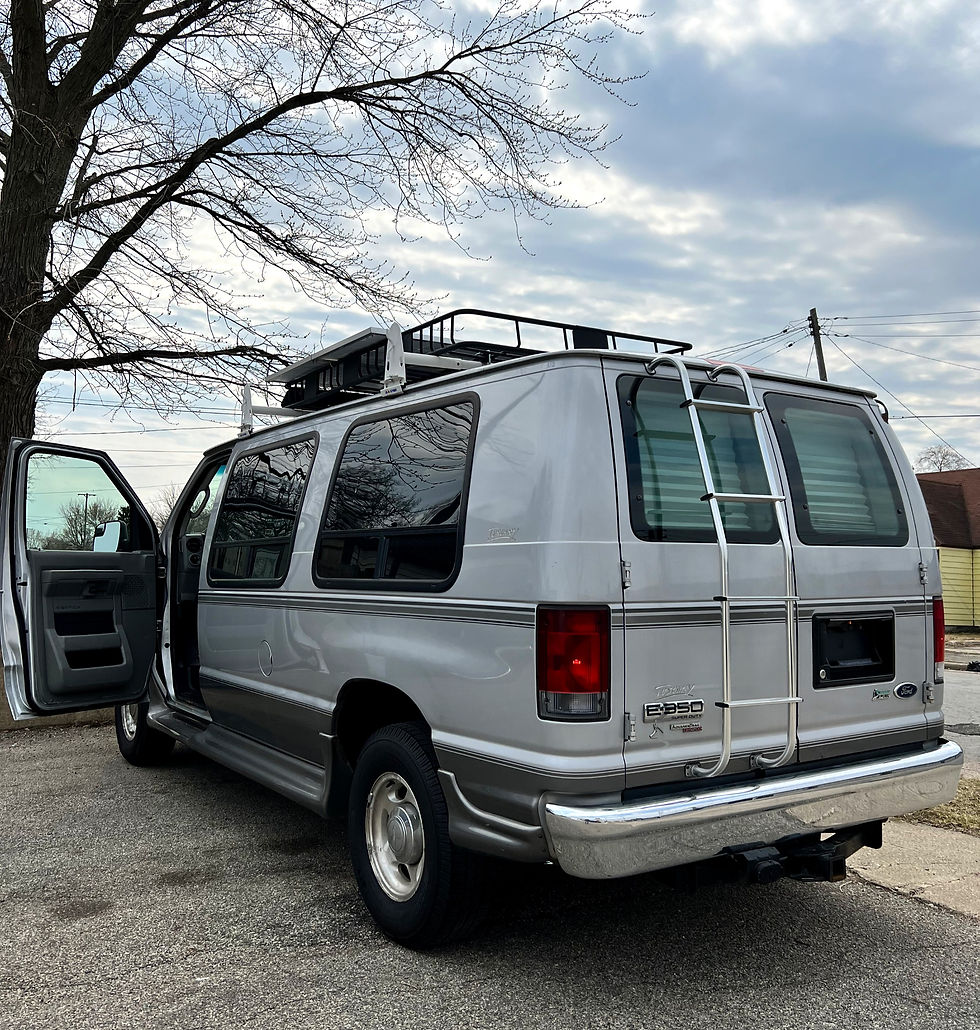
When it comes to self defense weapons, I generally think that it is better to be safe than sorry. If you are mentally stable, and of course can pass a background check, I recommend owning a firearm. For the same reasons many homeowners have at least one gun in the home, I recommend safely possessing a firearm in your conversion vehicle. Again, treat your van home as if it is an apartment or a house; in this case you need to not only defend yourself but all of your belongings as well.
I suggest a .380 or 9 millimeter for a more compact firearm that can be safely stowed in your vehicle. If you do not feel comfortable carrying a firearm, or are unable to, I recommend carrying a taser, brass knuckles, or any form of self defense weapon that can give you more physical advantage than just your own body.
Other small safety tips revolve mostly around mindfulness. Staying alert and cautious is key to staying safe on the road. Making small adjustments to your everyday life, such as stowing your vehicle keys closer to you at night, can be life-saving. If you are a female on your own, never get in and out of your van several times after you are parked at night (in rural areas you don't need to worry about this much). You never know who is watching. Always make sure the area you are camping out in each night is relatively safe, and be most aware of your surroundings after dark.
Converting a vehicle
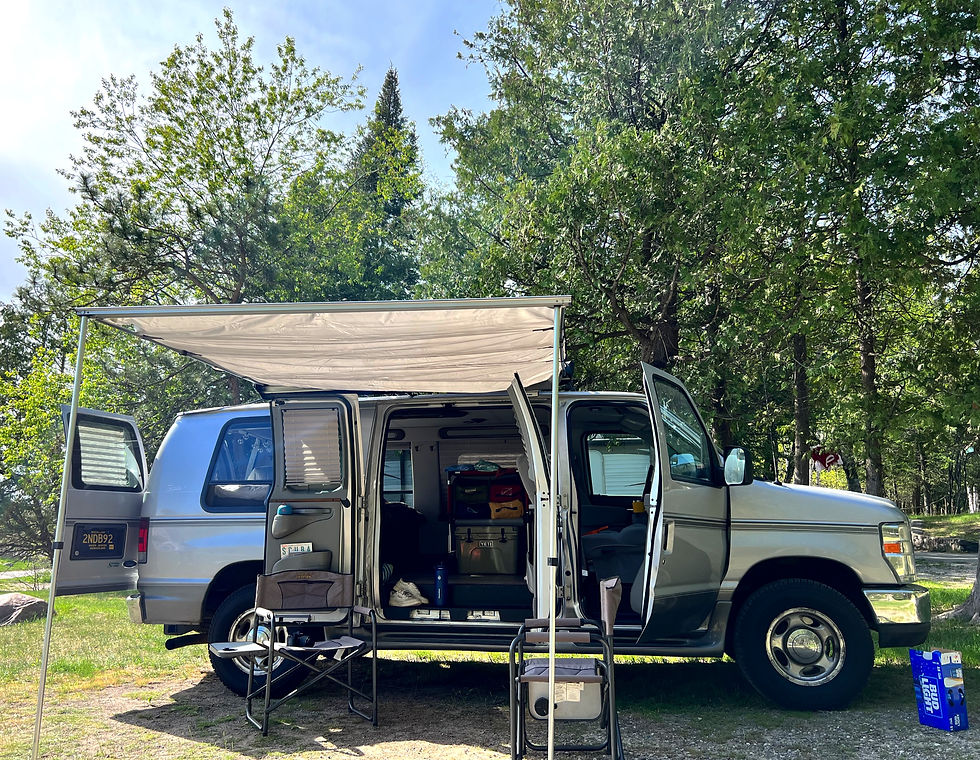
Above: My van, fully set-up for the perfect weekend camping trip in Northern Michigan, USA. 2022 by Hayley Babbitt.
So, after reading all about the nitty-gritty you're still deciding to start the van life? Welcome to the club! Let's start you off with how to convert a vehicle, and most importantly, how to acclimate to your new (lack of) space.
Although the most popular conversion vehicle is a van, more and more nomads are converting other vehicles in ways never thought of before. With one simple search on Pinterest, you will find that there is a seemingly endless amount of ways to convert a vehicle, whether you have a van, truck, school bus, or even a Tesla (shout-out to the new Tesla "camping mode" feature). The key to converting any vehicle is knowing "when there is a will, there is a way", and how that especially applies to creating enough space in your vehicle for all of the additions you want to make.
In this section of the guide, I am going to walk you through the steps of converting a van/vehicle and how I converted my own van. Depending on your budget, you may have the full hook-ups, such as an inverter, fridge, shower, etc., or you might have none of these luxuries at all.
The Bare Necessities
When I converted my van, Vinny, I had a very low budget for your typical conversion. When it comes to the typical conversion cost in 2023, you might find the average van-dweller dropping anywhere between $50k to $100k+ by the time they are done converting. In my case, my van cost around $9k as it was and I ended up spending roughly $3.5k on the conversion. Although I did my conversion rather "cheap", you can definitely tell the difference between a $150k conversion van and a conversion van worth around $9k (maybe even less now, considering Vinny has just over 300k miles). With this being said, I definitely went the "bare necessities" route in giving a few luxuries up with my limited space.
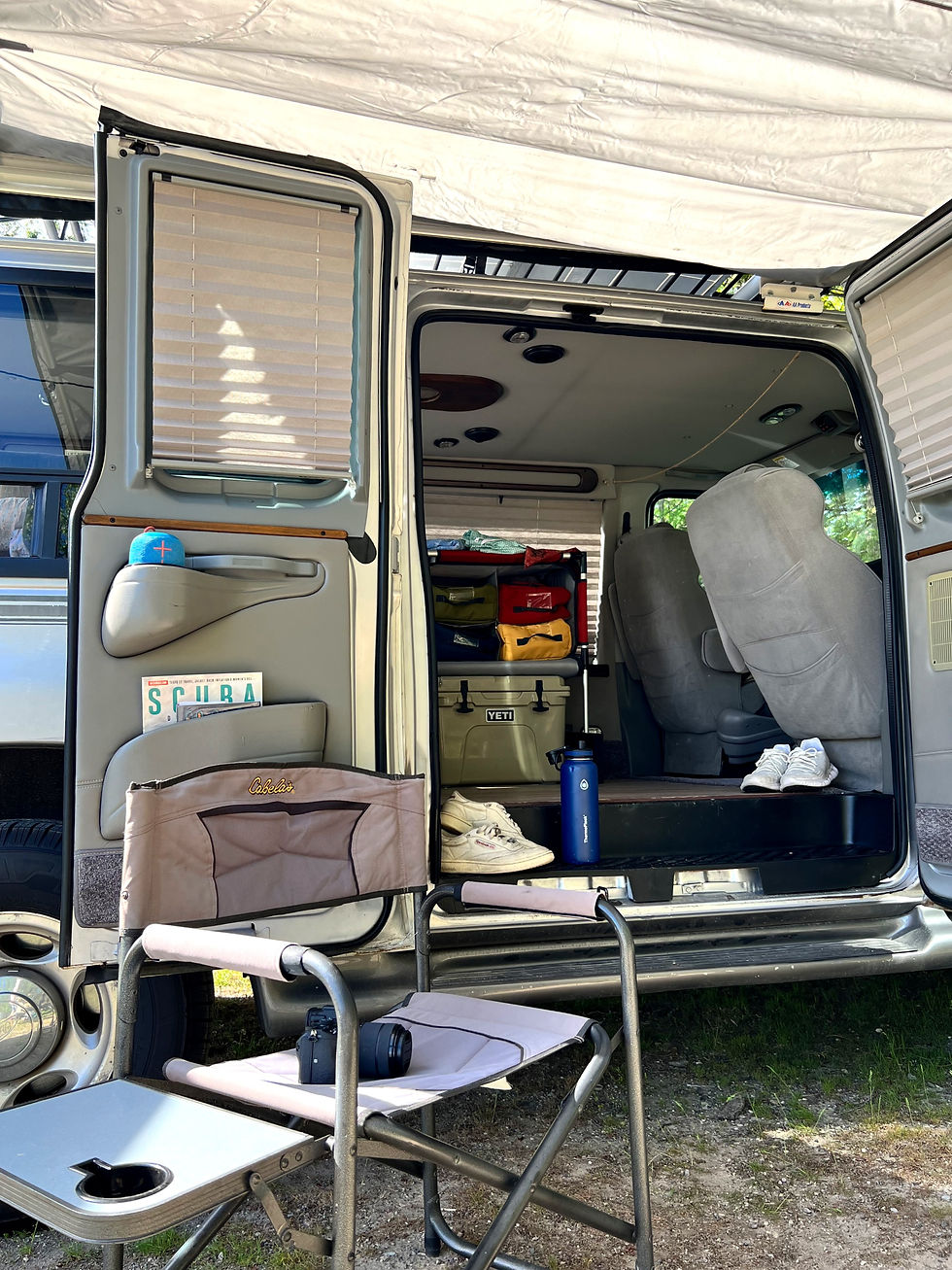
Above: A chill spot thanks to Vinny's canopy I added to him during the conversion. 2022 by Hayley Babbitt.
Vinny is a Ford Tuscany E350 which is a durable, reliable van (despite being quite the gas-hog). Since I keep good care of my van, I can still comfortably take my van off-roading without a worry of breaking down despite the high mileage. The biggest downside to having a non-sprinter is not being able to stand up inside the vehicle. It's not as big of a deal for me to live in a van I can't stand up since I'm about 5'2", but for average to taller height people it might take a bigger toll. Due to having a more compact space in my vehicle, that also means by bed is very short. My feet hang off of the ledge of my bed, so I usually sleep on a diagonal.
The more space you have in your conversion, the easier it will be to keep tidy; you might be surprised how quickly small spaces can get messy. It's one thing having a load of dirty laundry in a proper bedroom, but in a small conversion van it can mess up your whole "room" on just one lazy day (not to mention stinky, if you are camping out somewhere hot outside). I find myself cleaning my van everyday or every other day when I'm living on the road. The upside is that there is a lot less space to clean, so it's a manageable everyday practice that takes no longer than 10-20 minutes.

Above: A rare shot of my bed being made. 2022 by Hayley Babbitt.
When it comes to giving up everyday luxuries, my biggest I had to give up when living in my conversion van were running water, temperature control, and food storage. When I started living on the road, I had no idea how much I would appreciate simple things such as running water or having a refrigerator. When camping out in Walmart parking lots, being able to brush my teeth in the bathroom sink instead of using water from my water jug supply seems like a blessing. Think about if these comforts are necessary enough to account for in your build.
Storing food in a vehicle can be a pain in the ass. I personally have a Yeti cooler in my van, but I don't use it as often as I should due to the fact that I constantly am having to buy ice and change the water for very selective foods (you can't store anything frozen or much for left overs in a standard cooler). Aside from condiments and salsa, and other random foods that need to be semi-cool, coolers aren't as much help at being able to store food as a fridge. If you can get enough solar power to run a mini fridge, I would definitely recommend doing so to widen the variety of foods you can hold in your van.
The Conversion Process/My Setup
If you start with an unconverted vehicle, you will need to start by "gutting" the inside. With my van, I first took out all of the seats in the van (besides the driver and passenger seats). I then had pretty much bare bones to work with, which allowed me to then install the flooring and frame for my bed. When converting your vehicle, always try to maximize the little space you have in the beginning stages. For instance, I planned my bed frame structure to double as a large, underneath storage compartment.
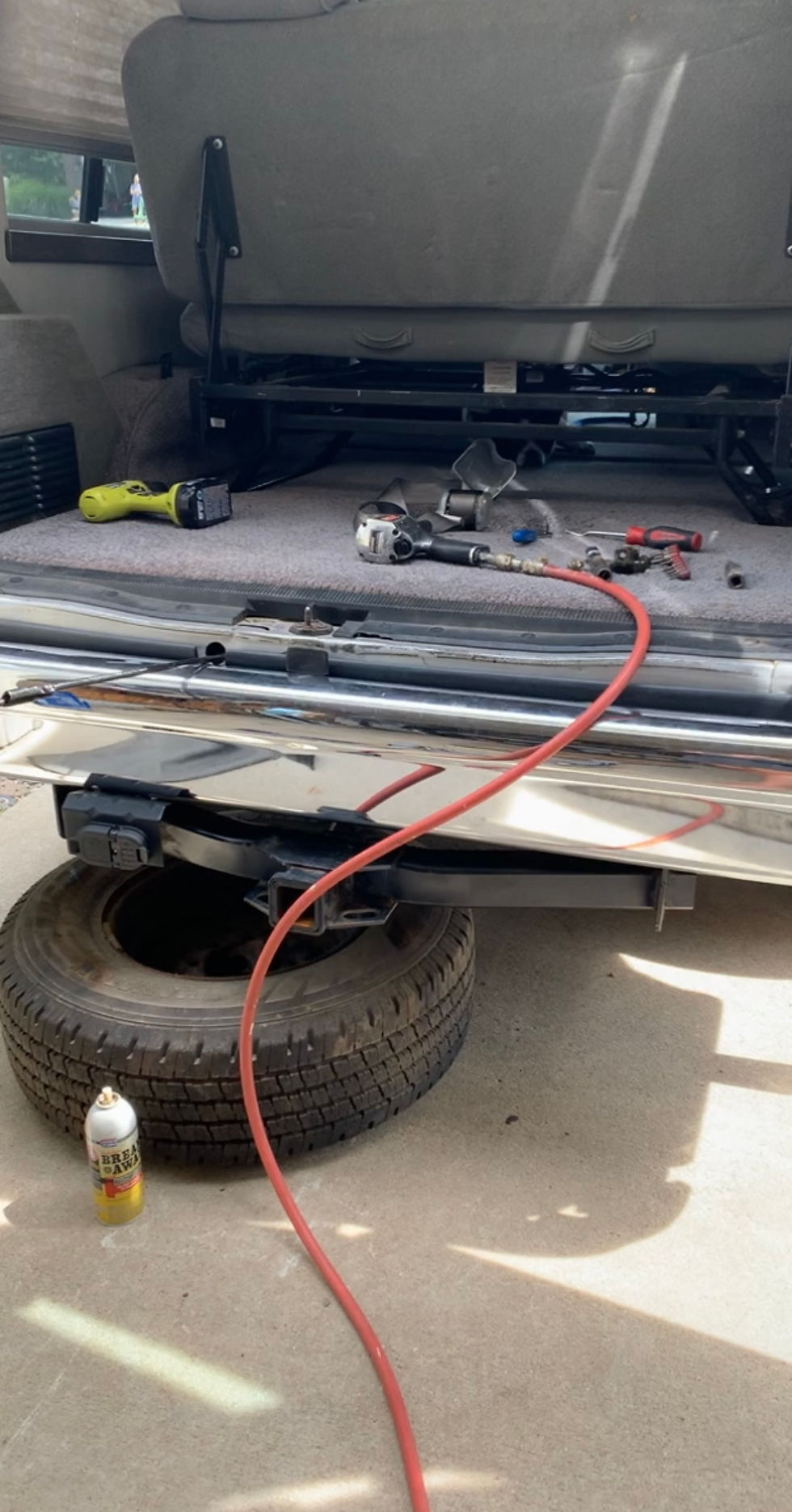
Above: The start to my gutting process of my van conversion. 2020 by Hayley Babbitt.
Other ways I utilize the most of my space is by strategically placing items such as my laundry basket, cookware station, and waste bin in convenient locations in my van. When I built the frame for my cookware station, I made sure to measure the dimensions around it so I could put it in place where my laundry and waste baskets could fit perfectly next to it. If you don't take the extra few minutes and measurements to make the most of your space, you will regret not doing so as you get along further in your conversion and realize you don't have enough space for comfort.
Since I built out my van in only 30 days on a budget, I did not document much of my conversion process. Below I will share a sketch of my van layout as well as a list of amenities and modifications, and you can do with this information what you will.
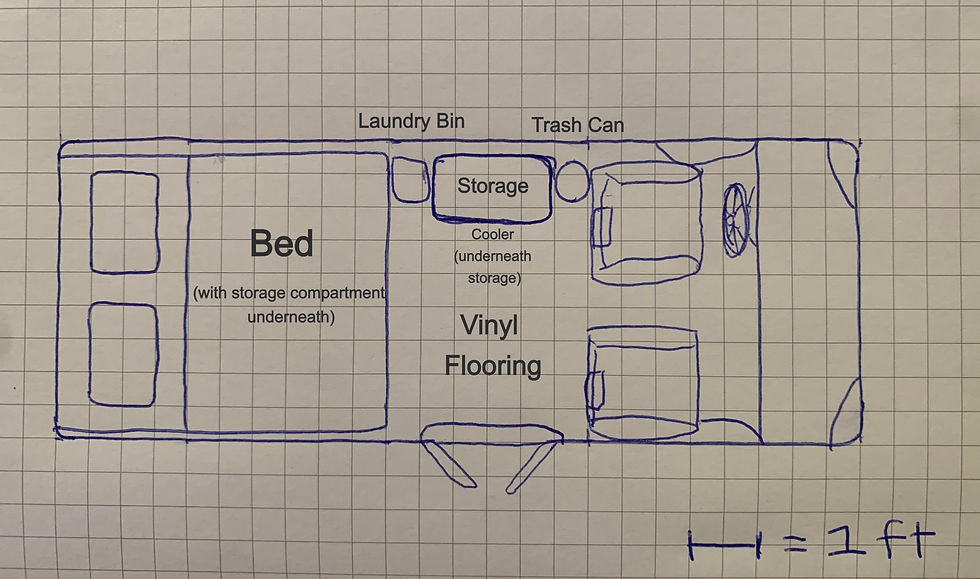
My Van's Amenities and Modifications:
Faux wood flooring
Custom wooden built-in bed frame and platform
Custom mattress
Built-in storage underneath bed
Built-in storage behind driver's seat
YETI cooler (stored beneath the central storage unit)
Trash can and laundry bin
Inverter
Outside awning
Roof rack
Two 150 watt Solar panels
Wifi router box
Why do I need solar panels?
Unless you are going to be in a new Tesla or have an RV, you are going to have to figure it out yourself when it comes to getting power. If you are going to be on the road for more than a couple of weeks, it's most practical to have your own power rather than relying on finding it around town. Solar panels, in my opinion, are typically the best way to have your own power source while living the van life.
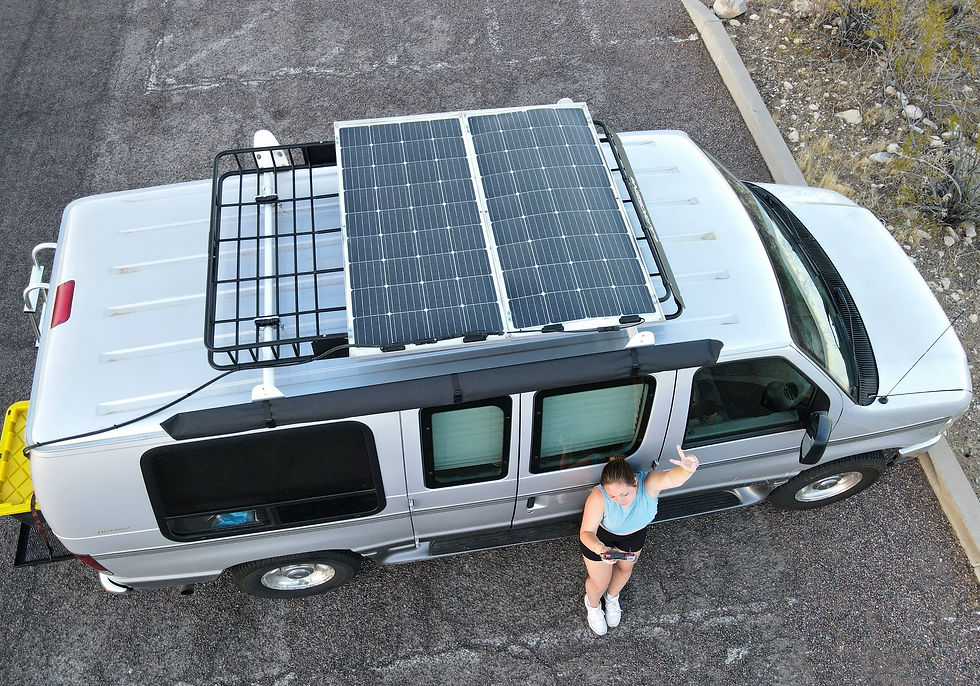
Above: A drone selfie with Vinny. 2021 by Hayley Babbitt.
Solar panels were the most expensive part of my conversion. With that being said, they truly elevated my simple build. Considering I was doing full time college from my laptop, running a drone startup, and had a part-time coding job, I had quite a bit of electronics to charge. Not to mention having a hobby as being a wildlife and landscape photographer, so my camera equipment was another story when it comes to keeping my electronics charged. Having my own power source was essential to my lifestyle on the road.
Setting up solar panels in your conversion isn't the easiest, unless you are familiar with electrical work. The good news is that you can learn how to do pretty much anything online now, so if you use your brain and be patient with yourself I think most people could figure it out. After fastening my panels to my roof rack, I cut a hole through the top of the van to run the cords from the panel to the inverter I built in underneath my bed. Hooked to that inverter is a battery cell that holds the power from the solar panels. That's about as simple as I can explain my power setup.
Like I mentioned previously; if you are living the van life in the modern day, you will most likely have an online job. That is if you are not WWOOFing. I found that having my own internet was pretty essential as well. This is why I invested in a small wifi router box. Without this little wifi hotspot, I wouldn't have been able to do my college classes from the middle of the South Dakota Badlands or Yellowstone National Park. As cute as it is stopping at coffee shops around America to do my online work, I personally prefer to work in remote nature. So with that being said, having my own wifi allowed me to have more freedom in terms of where I spent my days.
Why Van Life is Amazing
Let's end on a good note; let me tell you why van life (in my opinion) is one of the most amazing opportunities I have had in my life. Just as I am writing this now, it is almost hard to start writing due to having so many incredible memories flash before my eyes when pondering what to note first. Where do I begin?
I will never forget the day that I spent hopping alpine lakes in the Shasta-Trinity mountains. I had been hiking around the base of Mount Shasta the previous day, camping out on some shoulder of the mountain road leading up to Bunny Flats, and had taken note of the several alpine lakes hidden in the folds of the peaks. The beautiful shimmers from the water below me while I was looking down from the ridge of the mountain called my name, and so the next day that's where I headed. All day I played in these pristine alpine lakes, and I had felt a euphoria like no other from such a simple, happy day.

Above: One of the many alpine lakes in the Shasta-Trinity forest, California. 2023 by Hayley Babbitt.
I will never forget the angel that saved me in Wyoming. His name was Scott Seigfreid. I was depressed and alone in a Cody, Wyoming laundromat, when I had unexpectedly met a person that made me reconsider how I valued life. I was shown more kindness and compassion by a complete stranger than I have seen from anyone in many years. I was taught how to track wildlife in the rural west, capture photos of these beautiful creatures of God, and most importantly to understand the passion man innately has for creation and all of its creatures; all thanks to Scott. Scott taught me what it is to be a friend and what it is to love, and for that I could never thank him enough. Rest in peace, Scott.

Above: A portrait I took of Scott Seigfreid while he was demonstrating how to photograph wild bison in Lamar Valley, Yellowstone NP. 2021 by Hayley Babbitt.

Above: The ashes of my beloved friend, Scott Seigfreid, which I had brought to scatter where we had taken photos of the bison in Lamar Valley, Yellowstone NP. 2022 by Hayley Babbitt.
I could go on and on telling of beautiful moments in my life while living on the road. In all truthfulness, and not to sound corny, but van life saved me. I was in a dark place before making the transition to living out of a van, and hitting the road opened up my eyes to a lot of positivity that I was not seeing nor experiencing before.
Within a month or two of traveling around the United States in my van my perception of people had durastically improved in a positive way, my faith in humanity (all though not fully restored) was lifted, and my admiration for this world had grown immensely. And, most importantly, my self perception had completely changed. Going from hating to loving myself and then having the drive to create my own opportunities I owe all to my van, Vinny.
For some reason, all it took me was going for a drive. All it took was going out for a journey, not to any destination.
Comments